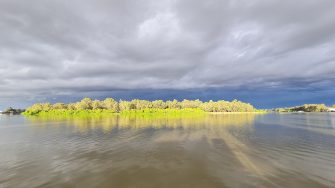
Date: Thursday, October 29, 2020
Project: Eastern Australian Waterbird Survey
Observers: Richard Kingsford UNSW, John Porter UNSW/DPIE
Pilot: James Barkell NSW National Parks & Wildlife Service DPIE
The weather was not great this morning. There were showers and thunderstorms coming across from the east, occasionally interrupted by patches of sunlight. We headed out from Goolwa to do the second counts of Lake Alexandrina and Lake Albert. With about a 30 knot wind, it wasn’t anything like the previous day’s surveying on the Coorong.
We flew around Lake Alexandrina in an anticlockwise direction, flying past one of the barrages which usually have hundreds and sometimes thousands of waterbirds. As when we came down the Coorong yesterday on the other side, there were hardly any waterbirds.
One of the really bright spots of Lake Alexandrina’s waterbirds, as in the past, were the breeding colonies. There is one particular inlet near the barrages where the pied cormorants breed in large numbers and they were at it again today, along with another smaller colony at the mouth of this inlet with a small royal spoonbill colony beside it.
There were hundreds of cormorants, pelicans and silver gulls, as we headed around Lake Alexandrina and then on to Lake Albert. Here great cormorants were clustered at the north end in their hundreds, among the reedbeds.
Once we had finished surveying Lake Albert, we headed along the southern boundary of Lake Alexandrina, past where the River Murray enters the lake and the cormorants roost in the willow trees.
Numbers of cormorants and pelicans continued to be high along the northern shoreline of Lake Alexandrina, along with swans, many with their broods, Australian shelduck and whiskered terns. There were only a few small flocks of grey teal and black duck and no hardhead or pink-eared ducks.
Along this northern shoreline of Lake Alexandrina, there were also about five colonies of straw-necked ibis, some in their thousands, usually with fewer white ibis. There was only one small ibis colony on Lake Albert, much smaller than last year.
After refuelling at Goolwa, we left the Lower Lakes and headed for the lower Murray.
On the way, we flew over the town of Murray Bridge, before we reached the river again, just east of the town of Beri and resumed our second count on this part of the river.
We were able to survey all the way along the River Murray’s main channel with its lagoons, just keeping in front of the storms that were on their way. The locks on the river conveniently divide it up into counting sections.
Along here, the river is particularly spectacular, with its large cliffs, but it has limited value for waterbirds because it is flowing so swiftly. The water it delivers to its floodplains is essential for its wetlands. We managed to survey all of the Chowilla floodplain and then headed back to Renmark before the storms came sweeping through.
Blog by Richard Kingsford
